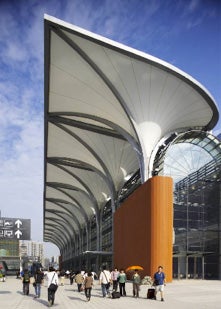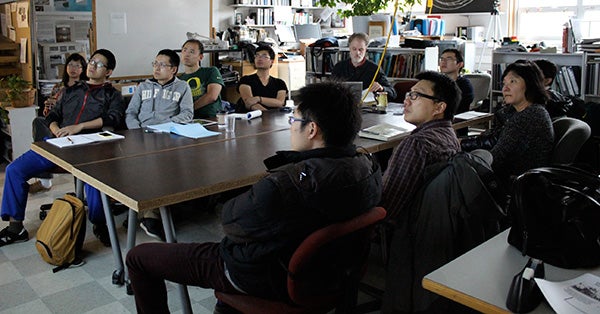Professional architects from Xian Dai Architectural Design Group in China are visiting the UO School of Architecture and Allied Arts this fall term for intensive study in sustainable architecture.
This marks the second year during which ten professionals from the Shanghai-based firm have come to UO for continuing education in their profession. Their visit is not only significant for furthering their careers, but the exchange program also bolsters the university’s top-ranked standing in sustainable design education.

Above: Xian Dai architect Kai Yang asks instructor Jeff Kline a question during a studio course in Lawrence Hall. Photograph by Emerson Malone.
The Shanghai-based Xian Dai was rated ninth in China (by Engineering News-Record) among engineering and architectural design firms. Their projects range from the Shanghai 2010 World Expo buildings to 100-story skyscrapers, from automobile showrooms to international airports.
Many of the visiting architects, in their mid-twenties to mid-thirties, have already won awards for their achievements. They have designed many large-scale projects, including sports arenas, hospitals, hotel resorts, and opera houses.
“This partnership between an innovative firm working on state-of-the-art projects and a program committed to sustainable design is significant in its own right,” said Brook Muller, A&AA associate dean and associate professor of architecture, during a welcoming reception the first week of fall classes. “It also provides a much-needed model of collaboration between professional and academic domains.”
Muller noted the importance of continuously renewing UO’s standing in nationally ranked programs.
“Given the pace of change [in architecture], you can’t sit there and rely on past accomplishments and expect to maintain your position,” he said. “Linkages to innovative practices within progressive design cultures are essential to maintaining a leadership role in architectural education, elevating the quality and relevance of our research, and adding richness to our intellectual culture.”
Muller teaches an interactive seminar, “History of Sustainable Architecture,” where both Xian Dai professionals and UO graduate students are tasked with developing personal research projects that assimilate theoretical and pragmatic perspectives.


Above Left: North Hall renovation of Shanghai Railway Station by Zhang Juxin. Photograph courtesy of the Center of Asian and Pacific Studies. Right: Shenyang Olympic Sports Center Stadium by Yang Kai. Photograph courtesy of the Center of Asian and Pacific Studies.
A studio with G.Z. “Charlie” Brown, Philip H. Knight professor and director of the Energy Studies in Buildings Laboratory (ESBL), teaches students and architects the theoretical fundamentals of sustainable design. The studio relies on physical models of buildings to analyze and understand the structure; this is a new concept for some of the visiting professionals who were trained to use software to create a digital model.
Jing Wang and Yujia Li, two of the visiting Xian Dai architects, cited a greater chance to communicate in class as another major difference from studying in China.
“Here, discussion is much more important,” said Yujia. “We can communicate with each other so we can change our minds so we can make our designs. We can get others’ opinion or [learn] something we didn’t realize. It’s very fantastic.”
“[The exchange program] creates a connection between architectural practices in China and A&AA. It means Xian Dai architects could learn a lot from the school, especially in [sustainability],” said Juxin Zhang, another Xian Dai architect. “Students of UO could have the opportunity to practice or work in Xian Dai through us.”
The Xian Dai guests visited Mount Angel Abbey in late October to see the library designed by Finnish architect Alvar Aalto and the Annunciation Hall designed by SRG architects with Charlie Brown’s Energy Studies in Buildings lab.
Other trips will explore architecture in Portland, nationally recognized as a pioneer in sustainable urbanism and design. Additional outings include visits to Seattle, Chicago, San Francisco, and Los Angeles. Some trips are structured through UO; others are independently planned.

Above: Hubei Radio and Television Station by Qiu Ronggang. Photograph courtesy of the Center of Asian and Pacific Studies.
The shift in cultural perspective adds a great deal to the course, said Muller, proving the visit educational for both cultures.
“Their transformation of the Chinese urban landscape is dramatic,” said Muller. “They have to assimilate new knowledge really quickly. The demands and the pressures for designing and building are great. The timeframes that they have to work within are a fraction of what I was accustomed to in architectural practice. … That’s great learning for us.”
Compared to Eugene or Portland, the climate of architecture practice is drastically different in Shanghai, where higher population density leads to greater competition and tighter work timeframes.
“The [Xian Dai] architects really relish the opportunity to step away from their intense work life and see how Oregonians live in harmony with nature,” said Nancy Cheng, associate professor and director of the architecture program at UO in Portland. Cheng, while on sabbatical, is in residence in Xian Dai to visit the different divisions.
“Meeting UO students who reuse, recycle, and compost helps bring to life the ideas in their sustainable design coursework,” she said.
Additionally, select UO architecture students have the opportunity to visit Shanghai for a summer internship at Xian Dai. This exchange program allows Oregon students to assist in planning cities, landscapes, and building complexes with the firm.
“I would surely recommend the internship to other UO architecture students, especially those who want to have a cultural experience that is radically different from their own culture,” said Tina Wong, a UO architecture student who interned with Xian Dai this past summer. “This internship is really a rare opportunity.”
Four students may participate in the internship each year, which takes place for two months. It is offered to students who have completed core studios, are eligible for 484/584 studios, and have three faculty member references.
In a field where the demands and expectations are constantly transforming, it is important to establish an association with a different culture’s architectural values, Muller said.
The Center for Asian and Pacific Studies and the UO Department of Architecture cosponsor this international exchange program.

Above: An image of Xian Dai's booth at the 2013 Green Building Technology Week. Photograph courtesy of the Center of Asian and Pacific Studies.

Above: The visiting Xian Dai architects sit in on a course on energy programming and microclimate design strategies taught by Jeff Kline. Photograph by Emerson Malone.
